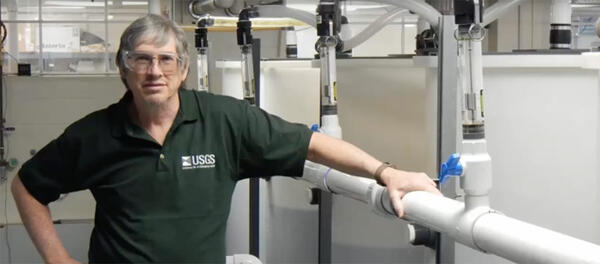Multicores collected from the northern Gulf of Mexico. These cores contain roughly 1 meter of sediment from the seafloor, and represent the past ~2000 years of deposition.
Images
Advanced Search
Filters
Advanced Search
Filters
Settings
Explore our planet through photography and imagery, including climate change and water all the way back to the 1800s when the USGS was surveying the country by horse and buggy.
Multicores collected from the northern Gulf of Mexico. These cores contain roughly 1 meter of sediment from the seafloor, and represent the past ~2000 years of deposition.
Picture of a mid-elevation plant community in the Mojave Desert.
Picture of a mid-elevation plant community in the Mojave Desert.
Back cover photo from

United States occurrence of microcystins in lakes in the contiguous 48 U.S. states categorized by World Health Organization relative probable health risk. WHO low, moderate, and high refer to the relative human recreational health thresholds for microcystin exposure. Map not shown to scale.
United States occurrence of microcystins in lakes in the contiguous 48 U.S. states categorized by World Health Organization relative probable health risk. WHO low, moderate, and high refer to the relative human recreational health thresholds for microcystin exposure. Map not shown to scale.
A look into the USGS Pacific Coastal and Marine Science Center’s Marine Minerals Laboratory Suite.
A look into the USGS Pacific Coastal and Marine Science Center’s Marine Minerals Laboratory Suite.
A look into the USGS Pacific Coastal and Marine Science Center’s Marine Minerals Laboratory Suite.
A look into the USGS Pacific Coastal and Marine Science Center’s Marine Minerals Laboratory Suite.
A look into the USGS Pacific Coastal and Marine Science Center’s Marine Minerals Laboratory Suite.
A look into the USGS Pacific Coastal and Marine Science Center’s Marine Minerals Laboratory Suite.
A look into the USGS Pacific Coastal and Marine Science Center’s Marine Minerals Laboratory Suite.
A look into the USGS Pacific Coastal and Marine Science Center’s Marine Minerals Laboratory Suite.

Permafrost forms a grid-like pattern in the National Petroleum Reserve-Alaska, a 22.8 million acre region managed by the Bureau of Land Management on Alaska's North Slope. USGS has periodically assessed oil and gas resource potential there. These assessments can be found here.
Permafrost forms a grid-like pattern in the National Petroleum Reserve-Alaska, a 22.8 million acre region managed by the Bureau of Land Management on Alaska's North Slope. USGS has periodically assessed oil and gas resource potential there. These assessments can be found here.
A perspective model of the morphology and geologic framework near Petit Bois Island showing the relationships between seafloor features and the subsurface. The barrier islands rest on the island plaftorm. Petis Bois Pass and offshore shoals are clearly visible from the acoustic surveys. The bathymetry, sidescan sonar, and sediment
A perspective model of the morphology and geologic framework near Petit Bois Island showing the relationships between seafloor features and the subsurface. The barrier islands rest on the island plaftorm. Petis Bois Pass and offshore shoals are clearly visible from the acoustic surveys. The bathymetry, sidescan sonar, and sediment
USGS inventor, Phil Sibrell, won 3rd place in the George Barley Water Prize competition in 2017, bringing home $10,000.00.
USGS inventor, Phil Sibrell, won 3rd place in the George Barley Water Prize competition in 2017, bringing home $10,000.00.
Photo of waves on the beach at Fire Island
Photo of waves on the beach at Fire Island
Photograph of moving-boat ADCP discharge measurements being made in Bayou Heron, Mississippi
Photograph of moving-boat ADCP discharge measurements being made in Bayou Heron, Mississippi
A Phragmites rhizome, or a belowground stem that puts up new shoots, dug up in a coastal marsh of Lake Erie in northern Ohio. Phragmites' belowground biomass can exceed that of its aboveground biomass.
A Phragmites rhizome, or a belowground stem that puts up new shoots, dug up in a coastal marsh of Lake Erie in northern Ohio. Phragmites' belowground biomass can exceed that of its aboveground biomass.
Introduced Phragmites australis, also called the common reed, is an invasive grass in the Great Lakes.
Introduced Phragmites australis, also called the common reed, is an invasive grass in the Great Lakes.

Helicopter pilot and crew discussing flight plan and data collection before lifting off.
Helicopter pilot and crew discussing flight plan and data collection before lifting off.
USGS pilot Sandy Brosnahan and Senate Pro Tempore Marc Pacheco discuss the use of Umanned Aerial Systems (UASs, also known as drones) to collect data in coastal environments.
USGS pilot Sandy Brosnahan and Senate Pro Tempore Marc Pacheco discuss the use of Umanned Aerial Systems (UASs, also known as drones) to collect data in coastal environments.
An interdisciplinary USGS team is conducting research and developing tools to identify suitable coastal habitats for species of concern, such as the piping plover (Charadrius melodus), under a variety of sea-level rise scenarios.
An interdisciplinary USGS team is conducting research and developing tools to identify suitable coastal habitats for species of concern, such as the piping plover (Charadrius melodus), under a variety of sea-level rise scenarios.

Organic Chemistry Research Laboratory -- Sacramento, California. Small sample bottles with pollen inside
Organic Chemistry Research Laboratory -- Sacramento, California. Small sample bottles with pollen inside
Back cover photo from

The 3DR Solo with GoPro Hero4 camera and gimbal. Coming to a survey area near you soon. Photo credit: Shawn Harrison, USGS. This photo was taken during USGS unmanned aerial systems (drone) pilot training. Two training sessions were held - one in February-March 2017 in Santa Cruz, California and the second in April 2017 in Gainesville, Florida.
The 3DR Solo with GoPro Hero4 camera and gimbal. Coming to a survey area near you soon. Photo credit: Shawn Harrison, USGS. This photo was taken during USGS unmanned aerial systems (drone) pilot training. Two training sessions were held - one in February-March 2017 in Santa Cruz, California and the second in April 2017 in Gainesville, Florida.

















